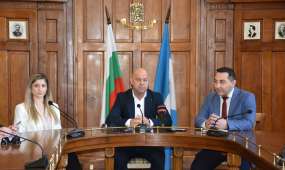The temple is built on a terrace on the north side of the top of Dzhambaz tepe (on the Three Hills). This makes it the highest Christian church built in the city. At this place in the beginning of XIX century there was a dilapidated late medieval church, dedicated to Saint Demetrius of Thessaloniki. Funds for the continuation of the construction were donated by wealthy Plovdiv citizens Ivan Politoglu, Valko and Stoyan Teodorovich Chalakovi, Stoyan Kurtovich Chalakov, Iskro Kesyakov, Todor Valkovich, and others. Anton Kamizopulos, merchant of Greek origin in Moscow, born in Plovdiv, donated valuable church-plates for the ordinance of the altar: Four Gospel, decorated with fittings, censers and vestments for the priests. Significant support was given by the Bulgarians from Karshiaka, the Plovdiv quarter on the north bank of the Maritsa River, who, for lack of their own parish church, went to in the St. Dimitar. The money for construction was enough, collected from almost all of the famous Plovdiv craft guilds, from compatriots and surrounding villages.
Probably the temple was built by the famous master from Bratsigovo, Stoyu Ivanov. He erected a representative three-nave pseudo-basilica whose western façade is formed by an open narthex with solemn marble colonnade. The columns are solid and end with heavy capitals, supporting semicircular arches. Above the narthex is built an emporium, open inwards to the temple as a balcony. Six pairs of stone columns divide the naos in three naves. The semicircular arches that connect them carry the massive, built with Rhodope travertine, semi-cylindrical vaults. The floor is completely covered with white marble slabs, and mosaic rosettes of colored stone are formed in the middle of the central nave. Most impressive is the marble iconostasis, the only monument of its kind in our Revival art. It was created in 1860-1869, by Adrianople and local masons, led by Greek artist A. Calumen. The funds for the expensive and impressive iconostasis were donated by the prominent resident of the parish, Ivan G. Politoglu.
The icons of the old church are well-preserved and so valuable medieval samples have survived until present times, among which the images of the Virgin Mary, Jesus Christ, St. Dimitar, St. Mina and others stand out, possibly from XV to XVIII century. The subsequent Renaissance icons were painted by Nikola Odrinchanin (in 1852, 1857 and 1861). The remarkable large Russian icon St. Anthony the Great was donated by one of the major donors in the resumption of the temple – Anton Kamizopulos. Today, from the old frescoes of the church, only the saints depicted in medallions between the arches of the colonnades in the naos are preserved.
The yard of the St. Dimitar temple is surrounded by high stone walls. In the western part there is the small chapel-holy spring, dedicated to the martyrs St. Cyricus and Julitta. In the north side of the narthex is the belfry, built in the ‘80s of XIX century by architect Josef Schnitter's design. The single storey building of the sexton’s house fits snugly to the southern fence wall. Next to the chapel, built on the high retaining wall, is the old priest’s home.
St. Dimitar is linked to the struggles for independent Bulgarian church of the Bulgarians in Plovdiv during the National Revival. After the ‘20s of XX century, after the exodus of the Greeks, the temple was granted for a while for religious needs of the Russian colony in the city, consisting of immigrants who came here after the October Revolution in Russia.











Add new comment